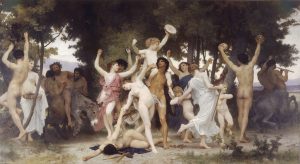Throughout “Dangerous Laughter,” there was an overwhelming and notable dread looming around the laugh parties. Something about them and the treatment of laughter as an intoxicant, a way to lose oneself for a moment, is eerie. The narrator and those around them are drawn to the laughter. Restlessness overcomes the narrator when they aren’t laughing. It becomes all consuming for the time being. That is, until Clara Schuler begins attending the parties. Her laughter is terrifying and yet, in a way, it is resplendent. She reaches a pinnacle of laughter that others can’t to the point that she quite literally laughs herself to death.
 These laugh parties are almost bacchanalian in their own way. There is a girl who is tickled “to the point of delirium,” and the laughter pushes people to injury more than once. (78) Clara, too, has a part in the resemblance to the bacchanal. Maenads, servants of Dionysus and the primary revelers in bacchanals, reach a point of intoxication that pushes them to frenzy. They lose themselves entirely to the celebration and lose themselves to a state of bliss that is reminiscent of Clara’s. While watching Clara laugh herself to death, the narrator notes that is seems like she is somewhere else in a place where “you were no longer yourself- you were no longer anything.” (91) There is a sort of horror to the raving laughter, the way that it overtakes people to the point of injury, and, at its most dangerous, to the point of death. Using Clara’s death as fodder for the newest trend between the teens in town, crying, makes it all the more horrific that she lost herself so wholly to laughter.
These laugh parties are almost bacchanalian in their own way. There is a girl who is tickled “to the point of delirium,” and the laughter pushes people to injury more than once. (78) Clara, too, has a part in the resemblance to the bacchanal. Maenads, servants of Dionysus and the primary revelers in bacchanals, reach a point of intoxication that pushes them to frenzy. They lose themselves entirely to the celebration and lose themselves to a state of bliss that is reminiscent of Clara’s. While watching Clara laugh herself to death, the narrator notes that is seems like she is somewhere else in a place where “you were no longer yourself- you were no longer anything.” (91) There is a sort of horror to the raving laughter, the way that it overtakes people to the point of injury, and, at its most dangerous, to the point of death. Using Clara’s death as fodder for the newest trend between the teens in town, crying, makes it all the more horrific that she lost herself so wholly to laughter.
I agree and do take this story to be one of the more disturbing we have read so far. Everything about it fits the description of a horror story, but not in a way you’d expect. The narrator doesn’t have an issue with what’s happening to them, which makes the tone all the more uncomfortable. It’s not until Clara joins their groups that the narrator notices something is off. Clara is better at them at laughing, she can last longer, laugh harder, everything. But when the entire town switches to crying, Clara misses being praised and tries to keep laughing, only to end in her demise.
Kate,
You are right to point out that there is a “notable dread looming around the laugh parties.”
Clara Schular, the quiet girl in school, is the one who becomes the best at these laughing games. On one hand, this is ironic, but on another hand, not so much. We have all experienced the “rise of an outcast” as I phrase it. There is a reason we root for the underdog. I think it might be because we see a little of ourselves in them. Millhauser does just this, where we root for the quiet girl who kept to herself. We see that she “finds” herself, and we, as the reader, are glad.
Except, as most stories exhibit, the rise of the underdog becomes the destruction of them, leading Clara Schular to her death.
What is the most devastating part of this, is that no one cared to check in on Clara Schular, showing us that her “friends” just wanted to be associated with her because of how she mastered the skill of laughter.